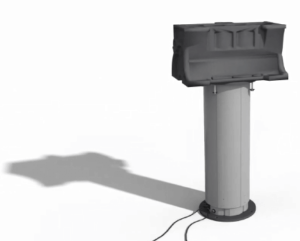Innovations in Heavy Lifting Equipment: What an Ergo I Can Do For Productivity
What is Heavy Lifting Equipment?
 For workplaces such as warehouses or manufacturing plants, heavy lifting equipment plays a pivotal role in helping support day-to-day operations. Heavy lifting equipment can refer to any broad number of different pieces of equipment, but its purpose is to help workers move or manipulate items that are too heavy or tough to otherwise lift. Some examples of heavy lifting equipment include items such as:
For workplaces such as warehouses or manufacturing plants, heavy lifting equipment plays a pivotal role in helping support day-to-day operations. Heavy lifting equipment can refer to any broad number of different pieces of equipment, but its purpose is to help workers move or manipulate items that are too heavy or tough to otherwise lift. Some examples of heavy lifting equipment include items such as:
- Cranes
- Forklifts
- Hoists
- Bulldozers
- Excavators
- Tote lifts
- Telescopic lifts
Heavy lifting equipment is specially designed to withstand massive loads of weight and stress. This makes it ideal for lifting heavy objects with safety and precision. Some common industries that use heavy lifting equipment include:
- Construction
- Manufacturing
- Logistics
- Aerospace
- Automotive
Read this blog article to learn more about heavy lifting equipment and the positive ways that it can impact your business. Then learn about Ergotronix’s Ergo I and the many innovative features it offers!
What Are the Risks Associated With Heavy Lifting?
When objects aren’t able to be safely lifted or manipulated in your workplace, there can be serious risks involved. Heavy lifting in particular is associated with a significant number of health issues, including:
Musculoskeletal Injuries
Heavy lifting can strain muscles, tendons, and ligaments, leading to injuries such as:
- Sprains
- Strains
- Tears
Improper lifting techniques or lifting objects that are too heavy can significantly increase the risk of these injuries.
Back Problems
Lifting heavy objects incorrectly can place excessive stress on the lower back, increasing the likelihood of developing spinal issues like chronic back pain or herniated discs. Prolonged exposure to such risks may result in long-term health issues.
Struck-by and Crush Hazards
When lifting heavy items, there is a risk of dropping them on oneself or others, causing serious injuries or even fatalities. Objects may also shift or fall from heights due to improper lifting, posing dangers to workers below.
Falls and Trips
Carrying heavy loads can affect a worker’s balance and visibility, increasing the chances of tripping or falling. In a warehouse, these accidents can lead to additional injuries if workers collide with equipment or other objects.
Cardiovascular Strain
Lifting heavy objects requires an increased heart rate and elevated blood pressure. Workers with preexisting cardiovascular conditions may be at higher risk of heart-related problems when engaging in strenuous lifting tasks.
Repetitive Strain Injuries
In a warehouse, heavy lifting tasks are often repeated throughout the day. This repetitive strain can lead to cumulative trauma disorders like tendonitis or carpal tunnel syndrome, causing pain and discomfort.
Fatigue and Overexertion
Continuously lifting heavy objects can lead to physical fatigue and overexertion, which can impair a worker’s cognitive function and decision-making ability, increasing the likelihood of accidents.
How Can Heavy Lifting Equipment Aid My Business?
Heavy lifting equipment makes things easier for everyone in the workplace, whether you’re a manager or a frontline worker. Here are some of the top ways heavy lifting equipment can benefit your operation:
Increased Efficiency
One of the most positive impacts of lifting equipment is that it increases job efficiency. When objects can be moved automatically and not manually, significant time is saved.
Enhanced Safety
As discussed above, manual lifting can come with some pretty serious risks! Besides just causing health issues, repetitive or heavy lifting can be exhausting for workers. By minimizing the involvement of human workers in lifting heavy objects, the risk of musculoskeletal injuries and accidents can be greatly reduced.
Precise Handling
Especially in the world of manufacturing, precise handling and placement of heavy objects is critical. Lifting equipment allows for much more accurate placing of loads than manual lifting does not.
Cost Savings
While it is true that purchasing heavy lifting equipment is an investment, there’s no denying that it is worth it. Heavy lifting equipment pays itself offer over time, in the form of elements such as:
- Labor requirements
- Increased productivity
- Minimized risk of damage to goods
- Preventing on-the-job accidents and injuries
Minimized Downtime
When heavy lifting is required, using appropriate equipment ensures minimal downtime. Machinery breakdowns or accidents due to manual lifting can lead to costly delays, which can be avoided with reliable lifting equipment.
Standardization and Consistency
Heavy lifting equipment allows for standardized lifting procedures, ensuring consistency in operations. This is particularly important in industries with stringent safety and quality standards.
Reduced Physical Strain
Heavy lifting equipment reduces the physical strain on workers, which can help improve overall job satisfaction and reduce absenteeism due to injuries or fatigue-related issues.
Regulatory Compliance
In many industries, there are regulations and guidelines governing the safe handling of heavy objects. Using lifting equipment helps companies adhere to these regulations, avoiding legal complications and penalties.
Introducing the Ergo I
Many industries, like manufacturing, have specialized heavy lifting needs. Being able to reach varying height levels is a must, so these industries tend to utilize some telescopic lift techniques. Telescopic lifts feature a retracting/expanding motion that provides great versatility.
When it comes to telescopic lifts, you want the highest quality manufacturing and best features possible. That’s why we’ve designed the Ergo I. A telescopic lift system has all of the elements you need to accomplish your day-to-day lifting operations.
The Ergo-I features:
- Telescoping lift with a small 10-inch footprint
- 400, 800, and 1200-pound load capacity per lift column
- Pneumatic or electric configuration
- 110V, 220V for stationary electric AC applications
- 12VDC or 24VDC for portable electric DC applications
- Synchronization of multiple units
- Built-in overload protection
- Universal top plate for ease of integration into the process
Ergotronix: Mobile Lifting Equipment
Here at Ergotronix, we develop cutting-edge smart lifting solutions for the workplace. In fact, our technology has been utilized by many Fortune 500 companies with equipment to support their operations. We offer innovative ergonomic equipment designed to both boost safety and productivity.
Want to get more information about one of our products or develop unique solutions for your workplace? Click here to contact us!



